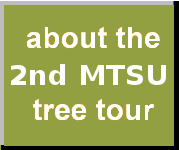
|

|

|
An individual instance of Ginkgo biloba (maidenhair tree)
Permanent unique identifier for this particular organism:
http://bioimages.vanderbilt.edu/mtsu/7
Notes:
Description
General: The ginkgo is a medium to large tree that reaches 20-35m tall, although some specimens in China are over 50m tall. Ginkgo trees often have angular crown and long, somewhat erratic branches. They are usually deep rooted and resistant to wind and snow damage. Young trees are often tall and slender, and sparsely branched, and the crown becomes broader as the tree ages. Some old ginkgos produce aerial roots which form on the undersides of large branches and grow downwards. This aerial root growth is very slow, and may take hundreds of years to occur. The function, if any, of these thick aerial roots is unknown.
Ginkgo branches grow in length by growth of shoots with regularly spaced leaves, so that several years' growth may only extend them by a centimeter or two. The leaves are ordinarily unlobed and appear to be clustered at the tips of short shoots. The leaves are unique among seed plants, being fan-shaped with veins radiating out into the leaf blade, sometimes bifurcating (splitting). The leaves are 5-10 cm (rarely to 15 cm) long. During summer, the leaves are a deep green, turning to brilliant yellow in the fall. They generally remain yellow for a time and then suddenly drop most of their leaves.
Habitat
The ginkgo is a drought-resistant, adaptable species, and is very cold hardy thriving. It is also very pH adaptable, tolerates air pollution and soil salt pollution, making it an ideal candidate for adverse urban conditions. It will grow in almost any conditions, it prefers deep, sandy, moist soil and requires full sun.
Uses
Commercial use: The ginkgo wood is of little value due to its scarcity. It is lightweight, brittle, yellow and in China and Japan, is used for chess sets, chopping blocks and firewood. The leaves are harvested for uses as a blood thinner and to treat circulatory illnesses.
Medical use: The extract from the ginkgo leaves contains flavonoid glycosides and ginkgolides. The extract is said to be a memory enhancer and anti-vertigo agent. Ginkgo is also added in small amounts to energy drinks.
Side Effects: Some of the undesirable effects of ginkgo include possible increased risk of bleeding, gastrointestinal discomfort, nausea, vomiting, diarrhea, headaches, dizziness, and restlessness.
Culinary use: The ginkgo nut-like gametophytes inside the seeds are a traditional Chinese food often served at weddings. They are believed to have health benefits or have aphrodisiac qualities. Japanese cooks add ginkgo seeds to dishes and cooked seeds are often eaten along with other dishes.
Reproduction
Ginkgos are dioecious with separate female and male sexes. Male plants produce small pollen cones and females produce ovules at the end of a stalk. Both can develop into seeds with a seed coat that is plum like and smells like rancid butter. The fertilization of ginkgo seeds is unusual in that it utilizes motile sperm; cycads are the only other seed plants with this feature.
Distribution
Ginkgos were once native throughout the Northern Hemisphere, but were rendered extinct in North America and Europe during the Pleistocene Ice Age. They survived in the Yangtze River valley in eastern China where they still grow today. The ginkgo has been cultivated for centuries in China and Japan and it is a sacred tree in the Far East.
Pests and Potential Problems
The ginkgo is disease resistant, has insect-resistant wood, and has the ability to form aerial roots and sprouts. This means the ginkgo lives long, with some specimens claimed to be more than 2,500 years old.
References
Wilson, J.D., & Moore, L.M. (2003). Plant guide for ginkgo (ginkgo biloba). Retrieved from http://plants.usda.gov/java/factSheet

|

|
|
Load database and switch to thumbnail view
Use this stable URL to link to this page:
http://bioimages.vanderbilt.edu/mtsu/7.htm
This particular organism is believed to have managed means of establishment.
This organismal entity has the scope: multicellular organism.
Identifications:
Ginkgo biloba
L.
sec. Tennessee Flora 2014
common name: maidenhair tree
family: Ginkgoaceae
Identified 2016-03-13 by Patrick Phoebus
Location:
Old Main Circle, Peck Hall, Rutherford County, Tennessee, US
Click on these geocoordinates to load a map showing the location: 35.848°, -86.3683°
Coordinate uncertainty about: 10 m.
Altitude: 188 m.
Location calculated as average of its images' coordinates.
Occurrences were recorded for this particular organism on the following dates:
2016-03-13
2016-04-27
The following images document this particular organism.
Click on a thumbnail to view the image and its metadata. Load database and enable navigation by taxon and organism.
| Image | View |

|
whole tree - unspecified |

|
whole tree - unspecified |
|
|
whole tree - general |
|
|
bark - unspecified |
|
|
bark - of a large tree |
|
|
leaf - unspecified |
|
|
cone - male |